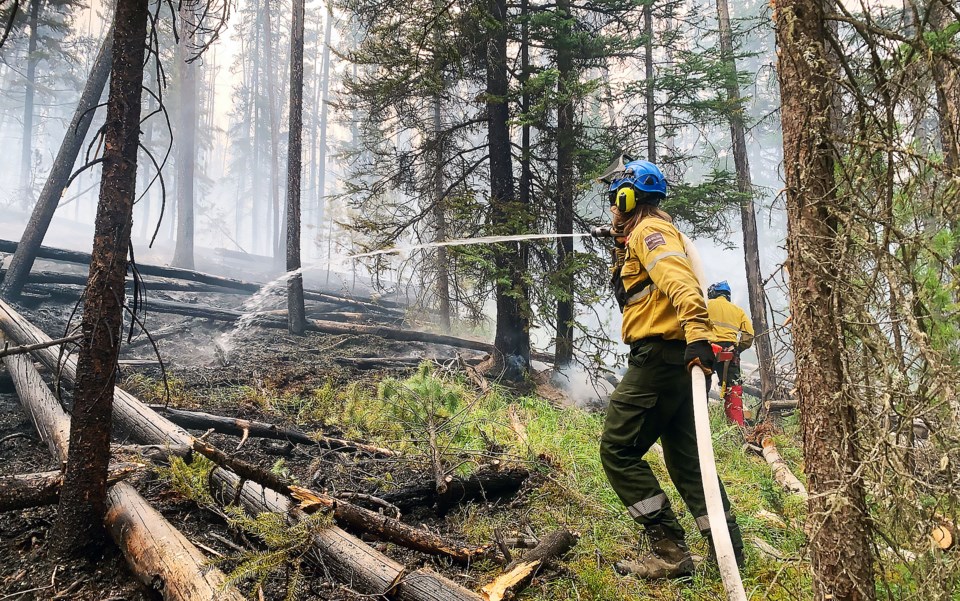BANFF – A prescribed fire in Banff National Park that spread onto neighbouring provincial land is no longer blazing out of control given recent snow and cooler temperatures.
The Dormer wildfire, which is estimated at 669 hectares, is now classified as being held, a status which means the wildfire is not expected to grow beyond pre-determined boundaries given current resources and forecast weather.
However, Parks Canada officials say strong, gusting winds and low relative humidity values are forecast for the eastern slopes over the next few days.
"Some precipitation is forecasted for this Friday (Oct. 28), however amounts will likely be insufficient to extinguish the fire," said Alexandria Jones, fire information officer for Banff National Park in an update.
"Fire behaviour may increase and trees that have been affected by the fire may fall within the area."
Provincial wildfire officers say Alberta Wildfire and Parks Canada continue to jointly work on the fire, with 20 personnel and two helicopters on scene.
“Approximately 10 centimetres of snow has fallen across the fire area, however, this amount is insufficient to extinguish the wildfire,” said Anastasia Drummond, provincial wildfire information officer for Calgary Forest Area in an Oct. 26 update bulletin.
“Crews continue to action hot spots south of the Dormer River.”
The average wildfire danger in the Calgary Forest Area is now low given the recent snowfall, as well as more seasonal temperatures and colder nights setting in.
Parks Canada and Alberta Wildfire responded to the fire in the Dormer Valley area on Oct. 20, which was estimated at about 500 hectares at the time. The next day, more accurate mapping pinned the wildfire at an estimated 669 hectares.
The prescribed fire getting out of control in Banff National Park was attributed to strong winds, above-average temperatures and low humidity.
“As a result of low humidity and high overnight winds, the Dormer Valley prescribed fire has experienced growth on the eastern national park boundary, crossing onto provincial lands,” said Jones.
The fire danger was rated as high at the time the prescribed fire spread.
By Friday afternoon (Oct. 21), there were up to 22 wildland firefighters and personnel, with four helicopters dumping water on the fire.
Resources were also dedicated to deploying sprinklers on cabins and outfitters’ camps in the area.
Jones said both agencies have been monitoring the Dormer Valley prescribed fire closely since the start of prescribed fire operations in early September.
She said up until the night of Oct. 19, the prescribed fire was active in isolated areas and was primarily burning within previously burned areas.
“However, due to unseasonable temperatures, low relative humidity values, and high winds, the fire spread eastward onto provincial lands,” she said.
Satellite imagery picked up that the fire spread overnight.
“As soon as there was enough daylight, a helicopter and fire crew were dispatched to the area to assess the fire,” said Jones.
“Suppression actions were immediately taken in coordination with Alberta Wildfire.”
The Dormer prescribed fire, located about 45 km north of the Banff townsite, was initially lit in early September.
The aim is to burn dense forests within the Dormer Valley and open up and restore grassland meadows, which provide critical, year-round habitat for mountain sheep, goats, grizzly bears, wolves, elk and the newly introduced bison herd.
Provincial forest area users adjacent to the park boundary should take caution. An area closure remains in place for the Dormer Valley, within the national park boundary.
Meanwhile, Parks Canada fire specialists were also actively monitoring an approximately 600-hectare backcountry wildfire that has been burning since Oct. 14.
The wildfire is located west of Glacier Lake on Highway 93 North, also known as the Icefields Parkway.
Smoke and flames were visible from certain sections of Highway 93 North.
“The public, infrastructure, and lands outside the park are not at risk from this wildfire,” said Jones.
“For public safety, an area closure is in place for the Glacier Lake Valley.”
According to Alberta Wildfire, there are currently 55 wildfires burning throughout Alberta, including three that started in the last 48 hours.




